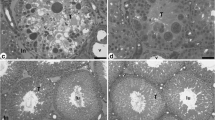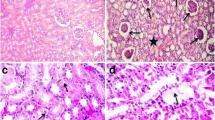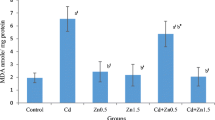Abstract
The cadmium-induced (Cd) damage of mammalian testes is thought to be correlated with an inhibition of carbonic anhydrase (CAH) by Cd. Since Cd causes dose-dependent changes in blood flow of the testes, an inhibition of CAH in the testes could be simulated by a decrease of CAH-rich erythrocytes. Therefore, CAH activities and hemoglobin (Hb) content were determined in blood and testes of untreated and Cd-treated Sprague-Dawley rats as well as in testes perfused via the testicular artery. Cd was intraperitoneally applied as CdCl2 in single doses of 1.5, 3.0, and 5.0 mg Cd2+/kg b.w., respectively.
-
1.
The experiments on perfused testes clearly demonstrated that the CAH activities originate from erythrocytes rather than from a tissue located enzyme.
-
2.
The alterations in blood circulation occurring shortly (0.25–1.0 h) after the Cd administration were characterized by a dose-dependent, transient decrease (1.5 mg Cd2+/kg) as well as an increase (3.0 and 5.0 mg Cd2+, respectively) of the Hb content in the testes.
-
3.
Independent of these minor alterations in a later state (14–24 h after 1.5 mg Cd2+/kg, 7–14 h after 3.0 mg Cd2+/kg, and 1–3 after 5.0 mg Cd2+/kg), Cd induced the well known hemorrhagic alterations of the testes with a high increase of Hb content and CAH activity.
-
4.
By means of the correlations between CAH activities and Hb content in blood and testes an inhibition of the CAH by Cd as the primary cause for the tissue damage of the testes could largely be excluded.
Zusammenfassung
Die bei Säugetieren durch Cadmium (Cd) hervorgerufenen Hodenschäden beruhen angeblich auf einer Hemmung der Carboanhydratase (CAH). Da Cd dosisabhängig die Hodendurchblutung beeinflußt, könnte jedoch durch eine Verminderung der Zahl CAH-reicher Erythrocyten eine Hemmung der CAH im Hoden vorgetäuscht werden. Wir bestimmten deshalb CAH-Aktivitäten und Hämoglobin (Hb)-Gehalt im Blut und im Hoden von unbehandelten und Cd-behandelten Sprague-Dawley-Ratten. Entsprechende Untersuchungen wurden an Ratten-Hoden durchgeführt, die vorher über die a. testicularis perfundiert worden waren. Die Ratten erhielten Cd intraperitoneal als CdCl2 jeweils in Einzeldosen von 1,5, 3,0 und 5,0 mg Cd2+/kg Körpergewicht.
-
1.
Die Untersuchungen an perfundierten Hoden zeigten deutlich, daß die im Hodengewebe bestimmten CAH-Aktivitäten nicht einer Hoden-CAH sondern vielmehr der Erythrocyten-CAH zuzuordnen sind.
-
2.
Bei den Cd-behandelten Ratten beobachteten wir kurze Zeit (0,25–1,0 h) nach der Cd-Zufuhr zunächst reversible Durchblutungsänderungen. Sie bestanden in Abhängigkeit von der Cd-Dosis sowohl in einer vorübergehenden Abnahme (1,5 mg Cd2+/kg) als auch in einer Zunahme (3,0 bzw. 5,0 mg Cd2+/kg) des Hb-Gehaltes im Hoden.
-
3.
Unabhängig von diesen geringfügigen Durchblutungsänderungen kam es später (14–24 h nach 1,5 mg Cd2+/kg, 7–14 h nach 3,0 mg Cd2+/kg und 1–3 h nach 5,0 mg Cd2+/kg) zu den bekannten hämorrhagischen Hodenveränderungen mit einer starken Zunahme des Hb-Gehaltes und der CAH-Aktivität.
-
4.
Anhand der Korrelationen zwischen CAH-Aktivität und Hb-Gehalt im Blut und im Hoden konnte eine Hemmung der CAH als primäre Ursache der Cd induzierten Hodenschäden ausgeschlossen werden.
Similar content being viewed by others
References
Alsen, C., Ohnesorge, F. K.: Determination of carbonic anhydrase (E.C. 4.2.1.1) activity by means of the pH-stat technique. Z. klin. Chem. 11, 329–332 (1973)
Elcoate, P. V., Fischer, M. J., Mawson, C. A., Millar, M. J.: The effect of zinc deficiency on the male genital system. J. Physiol. (Lond.) 129, 53 (1955)
Gunn, S. A., Gould, T. C.: Cadmium and other mineral elements. In: The testis, Vol. 3: Influencing factors. (V. D. Johnson, W. R. Gomes, N. L. Van Demark, Eds.). New York: Academic Press 1970
Hodgen, G. D., Butler, W. R., Gomes, W. R.: In vivo and in vitro effects of cadmium chloride on carbonic anhydrase activity. J. Reprod. Fertil. 18, 156–157 (1969)
Johnson, A. D., Miller, W. J.: Early actions of cadmium in the rat and domestic fowl testis. II. Distribution of injected 109cadmium. J. Reprod. Fertil. 21, 395–405 (1970)
Johnson, A. D., Walker, G. P.: Early actions of cadmium in the rat and domestic fowl testis. V. Inhibition of carbonic anhydrase. J. Reprod. Fertil. 23, 463–468 (1970)
Johnson, M. H.: The effect of cadmium chloride on the blood testis barrier of the guinea pig. J. Reprod. Fertil. 19, 551–553 (1969)
Koskimies, A. J.: Rapid appearance of excess serum protein in the rate testis in response to cadmium-induced increase of vascular permeability. Second International Symposium on Immunology of Reproduction, Varna, Abstract, p. 18 (1971)
Lindskog, S., Malmström, B. G.: Metal binding and catalytic activity in bovine carbonic anhydrase. J. biol. Chem. 237, 1129–1137 (1962)
Lindskog, S., Nyman, P. O.: Metal-binding properties of human erythrocyte carbonic anhydrases. Biochim. biophys. Acta (Amst.) 85, 462–474 (1964)
Maren, T. H.: Carbonic anhydrase: chemistry, physiology and inhibition. Physiol. Rev. 47, 597–765 (1967)
Ogawa, E., Suzuki, S., Tsuzuki, H., Kawajiri, M.: Basal study on early diagnosis of cadmium poisoning: Change in carbonic anhydrase activity. Jap. J. Pharmacol. 23, 97–105 (1973)
Parizek, J.: The destructive effect of cadmium ion on testicular tissue and its prevention by zinc. J. Endocr. 15, 56–63 (1957)
Parizek, J.: Sterilization of the male by cadmium salts. J. Reprod. Fertil. 1, 294–309 (1960)
Parizek, J., Benes, J., Kalouskova, J., Babicky, A., Lener, J.: Metabolic interrelations of trace elements. The effect of zinc salts on the survival of rats intoxicated by cadmium. Physiol. Bohemoslov. 1889–93 (1969)
Parizek, J., Boursnell, J. C., Hay, M. F., Babicky, A., Taylor, D. M.: Zinc in the maturing rat testes. J. Reprod. Fertil. 12, 501–507 (1966)
Setchell, B. P.: Testicular blood supply, lymphatic drainage and secretion of fluid. In: The testis, Vol. 1: Development, anatomy, physiology. (A. D. Johnson, W. R. Gomes, N. L. Van Demark, Eds.). New York: Academic Press 1970
Webb, M.: Protection by zinc against cadmium toxicity. Biochem. Pharmacol. 21, 2767–2771 (1972)
Author information
Authors and Affiliations
Rights and permissions
About this article
Cite this article
Alsen, C., Köpcke, C., Ohnesorge, F.K. et al. Effects of cadmium on carbonic anhydrase activity and hemoglobin content of rat testes. Arch. Toxicol. 37, 39–46 (1976). https://doi.org/10.1007/BF00353353
Received:
Issue Date:
DOI: https://doi.org/10.1007/BF00353353




